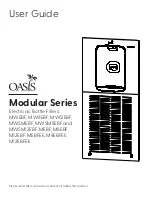
Garmin G1000 NXi Pilot’s Guide for the Cessna NAV III
190-02177-02 Rev. A
SY
STEM
O
VER
VIEW
FLIGHT
INSTRUMENTS
EIS
AUDIO P
ANEL
& CNS
FLIGHT
MANA
GEMENT
HAZARD
AV
OID
ANCE
AFCS
ADDITIONAL FEA
TURES
APPENDICES
INDEX
218
FLIGHT MANAGEMENT
NOTE:
Initiating the VNV direct-to function to the FAF, or manually creating an altitude constraint at the
FAF will inhibit the TTA function. See the Transition to Approach Function discussion later on in this section.
An altitude constraint is invalid if:
»
Meeting the constraint requires the aircraft to climb
»
Meeting the constraint requires the maximum flight path angle or maximum vertical speed to be exceeded
»
The altitude constraint results in a TOD behind the aircraft present position
»
The constraint is within a leg type for which altitude constraints are not supported
»
The altitude constraint is added to the FAF of an approach that provides vertical guidance (i.e., ILS or GPS SBAS
approach)
»
The altitude constraint is added to a waypoint past the FAF
Altitude constraints can be modified or deleted after having been added to the flight plan. In the event
an altitude constraint is deleted and the navigation database contains an altitude restriction for the lateral
waypoint, the system displays the altitude restriction from the database provided no predicted altitude can be
provided. The system also provides a way to reinstate a published altitude constraint that has been edited.
Entering/designating or modifying a waypoint altitude constraint to be used for vertical guidance:
1)
Press the
FPL
Key on the MFD to display the ‘FPL – Active Flight Plan’ Page.
2)
Push the
FMS
Knob, and turn to highlight the desired waypoint altitude constraint.
3)
Enter an altitude constraint value using the
FMS
Knobs. To enter altitudes as a flight level, turn the small
FMS
Knob counter-clockwise past zero or clockwise past 9 on the first character, and the system automatically
changes to show units of Flight Level. Turn the large
FMS
Knob clockwise to highlight the first zero and enter
the three digit flight level.
4)
Press the
ENT
Key to accept the altitude constraint; if the selected waypoint is an airport without a runway
selected, an additional choice is displayed. Turn the small
FMS
Knob to choose ‘MSL’ or ‘AGL’, and press the
ENT
Key to accept the altitude.
Removing/undesignating an altitude constraint:
1)
Press the
FPL
Key on the MFD to display the ‘FPL – Active Flight Plan’ Page.
2)
Push the
FMS
Knob, and turn to highlight the desired waypoint altitude constraint.
3)
Press the
CLR
Key. A ‘Remove VNV altitude?’ confirmation window is displayed.
4)
Select ‘OK’ and press the
ENT
Key.
Reverting a manually entered altitude constraint back to the navigation database value:
1)
Press the
FPL
Key on the MFD to display the ‘FPL – Active Flight Plan’ Page.
2)
Push the
FMS
Knob, and turn to highlight the desired waypoint altitude constraint.
3)
Press the
CLR
Key. A ‘Remove or Revert to published VNV altitude of nnnnnFT?’ confirmation window is
displayed.
Содержание G1000 NXi
Страница 2: ......
Страница 4: ......
Страница 16: ...Garmin G1000 NXi Pilot s Guide for the Cessna NAV III 190 02177 02 Rev A x REVISION INFORMATION Blank Page ...
Страница 20: ...Garmin G1000 NXi Pilot s Guide for the Cessna NAV III 190 02177 02 Rev A xiv TABLE OF CONTENTS Blank Page ...
Страница 537: ......
















































